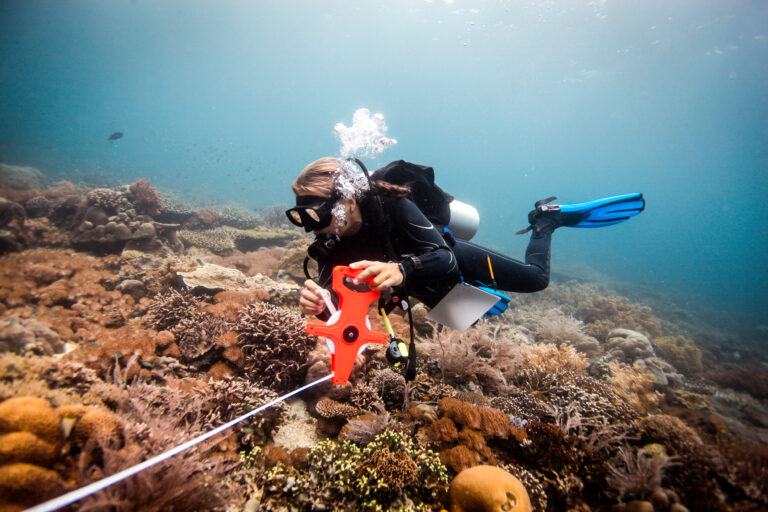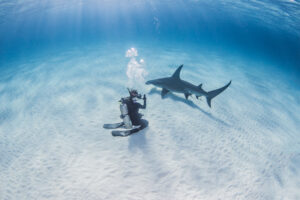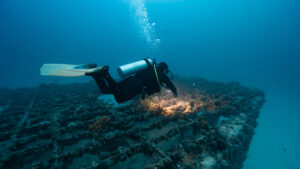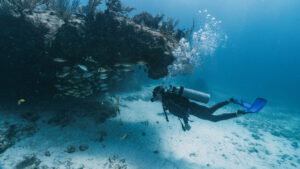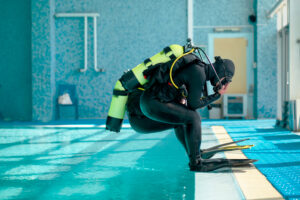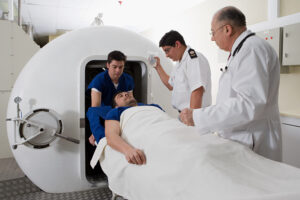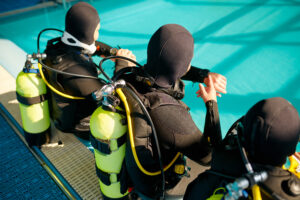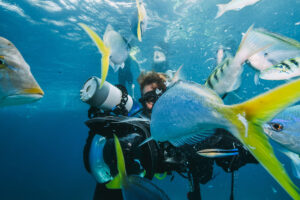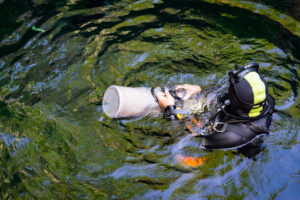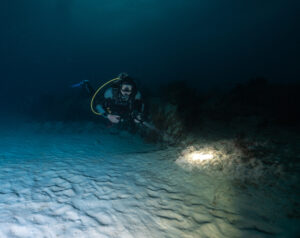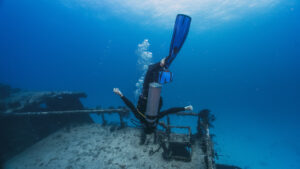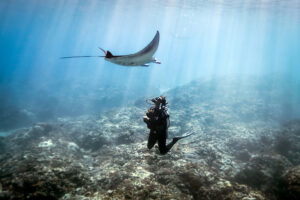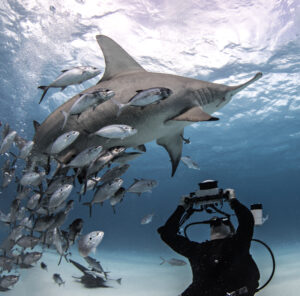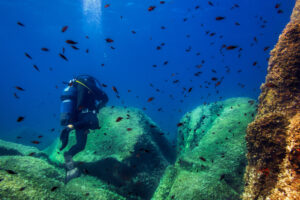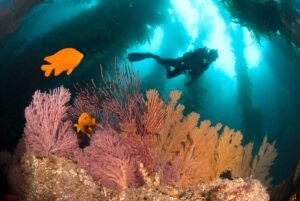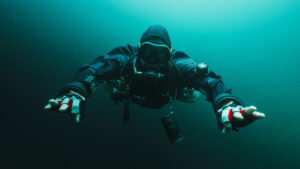What is Hyperventilation?
Hyperventilation refers to a state of rapid or deep breathing that exceeds the body’s need for oxygen. This condition leads to a significant decrease in carbon dioxide levels in the blood, causing various physiological effects. Understanding hyperventilation is crucial for scuba divers as it can profoundly impact their safety and overall experience underwater. Divers need to be aware of the causes, effects, and preventive measures related to hyperventilation to ensure safe and enjoyable diving experiences.
Definition and Basic Concepts
Hyperventilation occurs when an individual breathes faster or deeper than necessary, leading to an excessive expulsion of carbon dioxide. Normally, breathing maintains a balance between oxygen intake and carbon dioxide expulsion. However, when this balance is disrupted, the body experiences a decrease in carbon dioxide, known as hypocapnia. This can result in a range of symptoms, including lightheadedness, dizziness, and tingling in the extremities.
In the context of scuba diving, hyperventilation can occur due to various factors, including anxiety, physical exertion, or an attempt to prolong breath-holding. Unlike normal breathing, where carbon dioxide levels are maintained within a narrow range, hyperventilation disrupts this balance. This disruption can lead to a variety of physiological responses that are particularly dangerous underwater, where the immediate environment can exacerbate the effects of hyperventilation.
Understanding the difference between normal breathing and hyperventilation is key for divers. Normal breathing involves a steady exchange of gases, ensuring that oxygen is delivered to tissues while carbon dioxide is expelled efficiently. Hyperventilation, on the other hand, involves rapid or deep breaths that reduce carbon dioxide levels too quickly, impairing the body’s ability to regulate vital functions. Recognizing this difference is essential for divers to manage their breathing effectively and avoid the risks associated with hyperventilation.
Causes of Hyperventilation in Scuba Diving
Several factors can cause hyperventilation in scuba diving, ranging from environmental conditions to psychological and physical stressors. One significant cause is the environmental conditions divers encounter underwater. Cold water, poor visibility, and strong currents can increase anxiety levels, leading to rapid breathing as the body attempts to cope with these stressors. These environmental factors can trigger a stress response, causing divers to breathe more rapidly and deeply than necessary.
Physical exertion is another common cause of hyperventilation among divers. Swimming against currents, carrying heavy equipment, or engaging in strenuous activities can increase the body’s demand for oxygen. Divers may respond by breathing faster and deeper to meet this increased demand. However, without proper control, this can lead to hyperventilation. Physical fitness and experience play a crucial role in managing breathing rates during physical exertion underwater.
Emotional stressors, such as fear or anxiety, can also lead to hyperventilation. Divers may experience anxiety due to unfamiliar environments, concerns about equipment functionality, or the presence of marine life. This anxiety can trigger rapid breathing as a natural response to perceived threats. Effective stress management techniques, including controlled breathing and relaxation exercises, can help mitigate the impact of emotional stress on breathing patterns.
Equipment-related issues can contribute to hyperventilation as well. Poorly maintained or malfunctioning equipment can cause breathing difficulties, leading divers to overcompensate by breathing more rapidly. For instance, a regulator that delivers air inconsistently can cause a diver to hyperventilate in an attempt to get enough air. Regular equipment checks and maintenance are essential to prevent such issues and ensure smooth and controlled breathing underwater.
Physiological Effects of Hyperventilation
Hyperventilation has several physiological effects that can be particularly dangerous for scuba divers. One of the primary effects is the reduction of carbon dioxide levels in the blood. Carbon dioxide plays a critical role in regulating the body’s pH balance, and its reduction can lead to respiratory alkalosis, a condition where the blood becomes too alkaline. This shift in pH can cause various symptoms, including dizziness, confusion, and muscle cramps, which can impair a diver’s ability to function effectively underwater.
Another significant effect of hyperventilation is its impact on oxygen uptake. Although hyperventilation involves taking in more air, it paradoxically reduces the amount of oxygen available to the body’s tissues. This occurs because the decreased carbon dioxide levels cause blood vessels to constrict, reducing blood flow to vital organs, including the brain. This can lead to lightheadedness, impaired judgment, and, in severe cases, loss of consciousness, all of which are particularly hazardous in a diving environment.
One of the most dangerous consequences of hyperventilation for divers is the increased risk of shallow water blackout. Shallow water blackout occurs when a diver loses consciousness due to a lack of oxygen, typically during ascent. Hyperventilation reduces carbon dioxide levels, delaying the body’s natural urge to breathe. This can cause a diver to stay underwater longer than is safe, leading to a sudden blackout due to oxygen deprivation. This condition is especially perilous as it often occurs without warning, leaving the diver at risk of drowning.
The effects of hyperventilation on the body’s pH balance and oxygen uptake underscore the importance of maintaining proper breathing techniques while diving. Divers must be aware of the physiological changes that hyperventilation can cause and take steps to regulate their breathing to avoid these dangerous consequences. Understanding these effects is crucial for safe diving practices and effective emergency response.
Risks Associated with Hyperventilation
Hyperventilation poses several risks for scuba divers, making it essential to understand and mitigate these dangers. One of the primary risks is the increased likelihood of decompression sickness (DCS). Hyperventilation can cause a rapid ascent due to panic or loss of buoyancy control, increasing the risk of nitrogen bubbles forming in the blood and tissues. These bubbles can lead to DCS, a serious condition that requires immediate medical attention. Proper ascent techniques and controlled breathing are crucial to minimizing this risk.
Nitrogen narcosis is another risk that can be exacerbated by hyperventilation. Nitrogen narcosis, often referred to as “rapture of the deep,” is a condition that affects divers at depth, causing symptoms similar to intoxication. Hyperventilation can intensify these symptoms by reducing the body’s ability to expel nitrogen efficiently. This can impair judgment, coordination, and decision-making, increasing the risk of accidents underwater. Divers must be aware of the signs of nitrogen narcosis and take steps to manage their breathing to avoid compounding its effects.
Lightheadedness and the potential for unconsciousness are significant risks associated with hyperventilation. The reduction in carbon dioxide levels can cause cerebral vasoconstriction, leading to decreased blood flow to the brain. This can result in dizziness, confusion, and, in severe cases, fainting. Underwater, these symptoms can be life-threatening, as they impair a diver’s ability to navigate and respond to emergencies. Proper breathing techniques and stress management are essential to prevent these symptoms from occurring.
Long-term health risks of hyperventilation include chronic respiratory issues and potential damage to lung tissues. Repeated episodes of hyperventilation can lead to respiratory muscle fatigue and decreased lung efficiency. Over time, this can impact a diver’s overall respiratory health and performance. Divers should be mindful of their breathing patterns and seek medical advice if they experience recurrent issues related to hyperventilation.
Prevention Strategies
Preventing hyperventilation is crucial for ensuring safe and effective scuba diving experiences. One of the most effective prevention strategies is adopting proper breathing techniques. Divers should focus on slow, deep breaths rather than rapid, shallow breathing. Controlled breathing helps maintain the balance of oxygen and carbon dioxide in the body, reducing the risk of hyperventilation. Breathing exercises and practices such as diaphragmatic breathing can be beneficial in developing these techniques.
Maintaining calm and managing stress underwater is essential in preventing hyperventilation. Divers should practice relaxation techniques, such as visualization and mindfulness, to reduce anxiety levels. Staying calm helps regulate breathing and prevents the rapid, shallow breaths associated with hyperventilation. Additionally, divers should be aware of their mental state and take breaks if they feel overwhelmed or anxious during a dive.
Dive planning and familiarization with equipment play a significant role in preventing hyperventilation. Thorough pre-dive planning, including assessing environmental conditions and dive objectives, helps reduce stress and anxiety. Familiarity with equipment ensures that divers can manage their breathing efficiently and respond to any equipment-related issues without panicking. Regular training and practice dives can help reinforce these skills and build confidence underwater.
The buddy system is another crucial prevention strategy. Diving with a buddy provides an additional layer of safety and support. Buddies can monitor each other for signs of hyperventilation and offer assistance if needed. Effective communication and teamwork are essential in ensuring that both divers remain calm and controlled during the dive. Buddies should be trained to recognize the symptoms of hyperventilation and respond appropriately to mitigate risks.
Management and First Aid for Hyperventilation
When hyperventilation occurs underwater, immediate steps are necessary to manage the situation and prevent further complications. The first step is to try to calm the diver and slow their breathing. Encouraging the diver to focus on taking slow, deep breaths can help restore the balance of oxygen and carbon dioxide in the body. In some cases, it may be necessary to ascend slowly to shallower depths, where the diver can breathe more comfortably and regain control.
At the surface, further interventions may be required to manage hyperventilation. Divers should continue to focus on slow, controlled breathing to stabilize their condition. Removing equipment and ensuring the diver is comfortable and relaxed can also help reduce anxiety levels. If symptoms persist or worsen, it is essential to seek professional medical help. Medical professionals can provide additional treatments, such as oxygen therapy, to address the effects of hyperventilation and ensure the diver’s safety.
Post-dive care and monitoring are important for divers who have experienced hyperventilation. Even if symptoms appear to resolve quickly, divers should be monitored for any lingering effects or complications. Keeping track of the diver’s condition and any recurring symptoms can help identify underlying issues that may need further attention. Divers should also be encouraged to rest and avoid strenuous activities until they have fully recovered from the episode of hyperventilation.
Education and training are key components of managing hyperventilation in diving. Divers should be taught to recognize the signs and symptoms of hyperventilation and understand the appropriate response measures. Training programs should include practical exercises that simulate hyperventilation scenarios, allowing divers to practice their response techniques in a controlled environment. This preparation helps build confidence and ensures that divers are equipped to handle hyperventilation effectively.
Key Takeaways
Hyperventilation is a critical concern for scuba divers, with the potential to cause serious physiological effects and increase the risk of diving-related injuries. Understanding the causes, effects, and prevention strategies for hyperventilation is essential for ensuring safe and enjoyable diving experiences. Proper breathing techniques, stress management, and effective dive planning are crucial in preventing hyperventilation. Divers must also be prepared to manage hyperventilation if it occurs, with a focus on controlled breathing and appropriate first aid measures. Through education and training, divers can minimize the risks associated with hyperventilation and enhance their overall safety and performance underwater.

